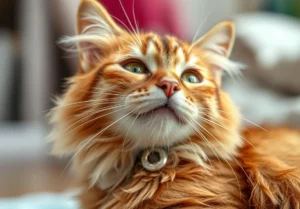As the seasons dance from the gentle spring breezes to the cozy winter chills, you might notice your feline friend acting a bit… off. It’s not just your imagination—our whiskered companions are sensitive to the changes around them, much like we are when we can’t decide whether to wear a sweater or a t-shirt.
In this post, we’re diving into the mysterious world of cats and seasons. We promise insight into how those seasonal shifts can stir up a storm in your cat’s behavior.
Key takeaways:
- Spring’s longer days and warmer weather increase your cat’s energy, leading to more ‘zoomies’—keep play engaging to match their mood.
- Shorter, colder days in winter can affect your cat’s mood and activity level; use daylight exposure and SAD lamps to combat seasonal blues.
- Adjust feeding routines and indoor stimulation in winter to manage increased appetite and ensure your cat stays active and healthy.
Why Does My Cat Get Zoomies More During Spring?
Have you ever noticed your furry friend tearing around the house at a hundred miles an hour, bouncing off the furniture, and seemingly acting out an imaginary high-speed chase during the spring months? Well, you’re not alone. This phenomenon, affectionately known as the ‘zoomies’, seems to hit our cats especially hard as the weather warms up and the days get longer. But why?
It’s all about the increase in daylight and warmer temperatures. Spring breathes new life into the world, and it seems to do the same for our cats. With the arrival of spring, cats experience a surge in energy levels, thanks to the longer daylight hours which can significantly alter their hormonal activity. This increase in light affects the hypothalamus in their brain, which, among other things, regulates their energy levels. The result? More zoomies!
Not only does the extended daylight encourage more activity, but the warmer weather also invites our cats to be more adventurous. They’re more inclined to explore and express their natural hunting instincts, which can often start or end as an indoor zoomie session. As a cat owner, embracing this energy can be both entertaining and beneficial for your cat’s health. Engaging in play during these bursts of energy can strengthen your bond and ensure they’re getting plenty of exercises. Just be sure to cat-proof your home as much as possible to avoid any zoomie-induced accidents!
Can Seasonal Changes Affect My Cat’s Mood?
As vibrant and playful as spring and summer can be for our cats, the shorter days and colder weather of autumn and winter can have the opposite effect.
Just like us, our furry companions can experience changes in mood with the seasons, sometimes showing signs that closely mimic human depression. The key culprit? The decrease in daylight.
During the darker months, some cats may exhibit more lethargic behavior, show less interest in playing, or even change their eating and sleeping patterns. These behaviors can be signs of Seasonal Affective Disorder (SAD), a type of depression associated with changes in seasons. While it’s more commonly recognized in humans, it doesn’t mean our pets are immune. If you notice a significant shift in your cat’s mood or behavior as winter draws in, it’s important to monitor them for signs of SAD. These can include:
- Increased sleep
- Less interest in play
- Changes in appetite or weight
To combat this, try to maximize their exposure to daylight by keeping your curtains open during the day and encouraging play near windows. A SAD lamp designed for pets can also be a beneficial investment, providing artificial sunlight that mimics the effects of natural daylight.
Is My Cat Eating More Because It’s Winter?
Yes, it’s possible! As the mercury drops, you might notice Fluffy heading to her food bowl more often. This isn’t just a coincidence. In colder months, cats, like many animals, instinctively eat more. This is a natural behavior linked to survival; extra layers of fat help them stay warm. However, in the comfort of a temperature-controlled home, this extra calorie intake isn’t necessary and can lead to unwanted weight gain.
Monitoring your cat’s diet and maintaining a consistent feeding routine is vital during winter. Here are a few tips to ensure they’re eating healthily:
- Measure their food to avoid overfeeding.
- Maintain a balanced diet, rich in nutrients.
- Engage in interactive play to keep them active and help burn off any extra calories.
Here’s a tip that might not be on every cat owner’s radar: consider introducing more wet food during colder months. Wet food can help keep your cat hydrated, which is especially important as indoor heating can lead to drier air.
Remember, every cat is unique, and what works for one might not work for another. Keeping a close eye on your cat’s behavior and adjusting care as necessary is the key to ensuring they stay happy and healthy, whatever the season.
How Can I Help My Cat Adjust to Seasonal Changes?
As the seasons shift, our feline friends might display changes in behavior, reflecting their unique responses to the changes in their environment. Understanding these nuances and learning how to ease their transition can ensure they remain happy and healthy year-round. So, let’s dive into some practical advice that’ll pave the way for a smoother seasonal adaptation for your beloved cat.
Keep the Routine Rock Solid
Cats are creatures of habit, and maintaining a consistent routine is paramount, especially when the world outside is undergoing significant change. Here’s how you can keep their world steady:
- Meal Times: Aim to feed your cat at the same times every day. This consistency offers a sense of security amidst the inevitable changes happening outside.
- Play Sessions: Regular, predictable playtimes can not only help keep your cat active but also mentally stimulate them, crucial during less active colder months.
- Cuddle Hours: Don’t forget the power of soothing cuddles. Set aside daily moments for affection, reinforcing your bond and providing comfort.
Indoor Stimulation is Key
During the colder months, outdoor adventures might become less appealing or even risky for your feline pal. Here’s where indoor stimulation comes into play:
- Interactive Toys: Puzzle feeders, laser pointers, and interactive toys can keep your cat’s body and mind sharp. Switch these up regularly to keep things interesting.
- Cat Trees and Perches: Offering vertical spaces for climbing or lounging can simulate an outdoor environment, satisfying their instinct to survey their domain from a height.
- DIY Fun: Simple homemade toys or challenges can be incredibly engaging. An example is hiding treats around the house for your cat to find, mimicking the hunt they would engage in outdoors.
Comfort is Crucial
Ensuring your cat feels safe and stress-free during seasonal transitions can make all the difference. Here’s how you can create a comforting environment:
- Warm and Cozy Spaces: As temperatures drop, provide warm blankets or even a heated bed in a safe, quiet corner where they can retreat.
- Controlled Environment: Keep your home at a comfortable temperature. Sudden changes in indoor temperature can be as unsettling as the changing weather outside.
- Consult Your Vet: Changes in behavior can sometimes signal health issues. A vet visit can offer peace of mind or catch any problems early on.
The Unique Tip Your Cat Will Love
Rotate Their View: Here’s a gem not often mentioned – consider rotating your cat’s favorite bed or perch to different windows around the house throughout the year. This simple action provides them with varied outdoor views and sun exposure, mimicking a more dynamic outdoor environment. It’s a simple, yet effective way to keep their environment stimulating regardless of the season. This can be particularly engaging as the outdoor scenery changes, offering them new sights, sounds, and smells without ever stepping a paw outside.
Transitioning between seasons doesn’t have to be a rough ride for your cat. With these guidelines, you can help ensure that your cat navigates these changes with ease, staying both engaged and comfortable no matter what the weather outside is doing. Embrace these tips, and watch your cat thrive all year round, enjoying a happy and balanced life by your side.
Alex, a passionate animal lover, has experience in training and understanding animal behavior. As a proud pet parent to two dogs and three cats, he founded AnimalReport.net to share insights from animal experts and expand his knowledge of the animal kingdom.





